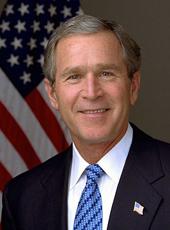"[N]early a year ago, we saw the terrorists, cold-blooded killers, using our openness, the openness of our societies against us. We were awakened to threats that can arrive across our borders ... We have no choice but to confront the threats head-on, while we preserve the freedom and the openness of our societies."
President George W. Bush
September 9, 2002
"As we accelerate our progress against terrorism, APEC economies must also move to meet the challenge of encouraging global economic growth and bringing the benefits of global markets to all our peoples. Consequently, we must grow our economies even as we protect our borders and find new ways to secure our key economic infrastructure from terrorist attacks."
APEC Leaders' Statement on Fighting Terrorism and Promoting Growth
October 26, 2002
Presidential Action
- Today President Bush, together with other APEC leaders, launched 'Secure Trade in the APEC Region' (STAR) designed to enhance security while increasing trade.
- The STAR initiative commits APEC economies to accelerate action on screening people and cargo for security before transit; increasing security on ships and airplanes while en route; and enhancing security in airports and seaports.
This initiative complements the transport security initiative President Bush secured at the G-8 Kananaskis Summit this June, as well as smart border programs President Bush has launched with Mexico and Canada and advances a vision of security that pushes the perimeter beyond the physical border. A number of APEC economies, encompassing most of the biggest ports in the region, have also agreed to participate in the U.S. Customs Container Security Initiative.
The Challenge: The terrorist attacks on September 11, 2001, illustrated how critical the international transport system is to our economic and national security. We must promote the efficient and reliable movement of people and goods across borders, while preventing the tools of transport from becoming tools of terrorism:
- APEC countries account for over 50 percent of the world's trade, 21 of the world's 30 top container seaports, and 23 of the world's 30 busiest airports.
- Approximately 90 percent of the world's cargo moves by container.
- Globally over 48 million cargo containers move between major seaports each year. Each year, more than 16 million containers arrive in the United States by ship, truck, and rail.
- More than 14,000 planes are flying in the global fleet of commercial airlines.
APEC Plan of Action: The U.S. proposed earlier this year that APEC address this challenge by advancing secure trade initiatives. Today APEC agreed and committed to a plan of action that will:
- Protect cargo by
- Identifying and examining high-risk containers, assuring in-transit integrity, and providing advance electronic information on containers to customs, port, and shipping officials as early as possible in the supply chain;
- Implementing by 2005 common standards for electronic customs reporting;
- Promoting private-sector adoption of high standards of supply chain security.
- Protect ships by
- Promoting ship and port security plans by July 2004 and installation of automatic identification systems on certain ships by December 2004;
- Cooperating to fight piracy in the region.
- Protect international aviation by
- Introducing new baggage screening procedures and equipment in all APEC major airports by 2005;
- Reinforcing flight deck doors for passenger aircraft by April 2003;
- Supporting International Civil Aviation Organization (ICAO) mandatory aviation security audits.
- Protect people in transit by
- Implementing a common global standard on advance passenger information.
- Adopting biometrics standards, such as those being developed by the ICAO and the International Standards Organization.
- Reforming immigration service procedures.
- Promoting adoption of air cargo security guidelines developed by ICAO and the International Air Transport Association (IATA).
Container Security Initiative and other U.S. Efforts: The United States has been working bilaterally and multilaterally to keep the arteries of commerce clear while strengthening security surrounding the world's transportation infrastructure. We have comprehensive smart border initiatives underway with Mexico and Canada that use modern technology to enhance security and expedite legitimate cross-border travel and commerce. The U.S. Customs Service is, through its Container Security Initiative (CSI), partnering with key ports to introduce pre-screening and risk analysis of cargo containers based on advance information. Fifty percent of containerized cargo shipments to the United States originate in 10 key megaports, 6 of which are in APEC. Singapore, Hong Kong, Japan, Canada, and most recently China have agreed to participate in CSI, and we are seeking to expand CSI to a number of other Asia-Pacific countries.
George W. Bush, Fact Sheet: Secure Trade in the APEC Region ("STAR") Online by Gerhard Peters and John T. Woolley, The American Presidency Project https://www.presidency.ucsb.edu/node/280501

